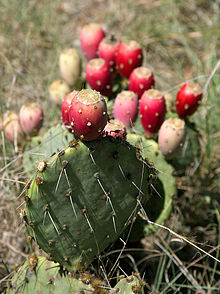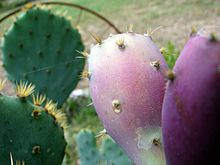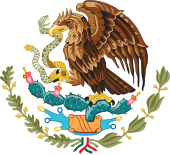Opuntia
The genus is named for the Ancient Greek city of Opus,[3] where, according to Theophrastus, an edible plant grew and could be propagated by rooting its leaves.The flowers are typically large, axillary, solitary, bisexual, and epiperigynous, with a perianth consisting of distinct, spirally arranged tepals and a hypanthium.[8] Chollas, now recognized to belong to the distinct genus Cylindropuntia, are distinguished by having cylindrical, rather than flattened, stem segments with large barbed spines.fragilis, has been found growing along the Beatton River in north-eastern British Columbia, southwest of Cecil Lake at 56° 17’ N latitude and 120° 39’ W longitude.[13] Prickly pears produce a fruit known as tuna, commonly eaten in Mexico and in the Mediterranean region, which is also used to make aguas frescas.[1] The first introduction of prickly pears into Australia is ascribed to the founding governor of the New South Wales colony, Arthur Phillip, and the earliest European colonists, in 1788.The cactus quickly became a widespread invasive weed in the dry interior climate west of the Great Dividing Range, in New South Wales and Queensland,[16] eventually converting 260,000 km2 (101,000 sq mi) of farming land into an impenetrable green jungle of prickly pear, in places 6 m (20 ft) high.Scores of farmers were driven off their land by what they called the "green hell", and their abandoned homes were crushed under the cactus growth, which advanced at a rate of 400,000 hectares (1,000,000 acres) per year.[17] The release of cochineal insects, which eat the cactus and simultaneously kill the plant, has also proven an effective measure for combating its spread.[18] Natural distribution of the plant occurs via consumption and associated seed dispersal by many animals, including antelopes, nonhuman primates, elephants, birds, and humans.[19] O. ficus-indica thrives in regions with mild winters having a prolonged dry spell followed by hot summers with occasional rain and relatively low humidity.[27] If the outer layer is not properly removed, glochids can be ingested, causing discomfort of the throat, lips, and tongue, as the small spines are easily lodged in the skin.[28] In Mexico, prickly pears are often used to make appetizers, soups, salads, entrees, vegetable dishes, breads, desserts, beverages, candy, jelly, and drinks.In Sardinia, they are called figumorisca ("Moorish figs"), the same denomination they receive along the Catalan-speaking regions of the Western Mediterranean, figa de moro.They can be found also in the Struma River in Bulgaria, in southern Portugal and Madeira (where they are called tabaibo, figo tuno, or "Indian figs"), in Andalusia, Spain (where they are known as higos chumbos).The prickly pear also grows widely on the islands of Malta, where it is enjoyed by the Maltese as a typical summer fruit (known as bajtar tax-xewk, literally "spiny figs"), as well as being used to make the popular liqueur known as bajtra.In Morocco, Tunisia, Libya, Saudi Arabia, Jordan, and other parts of North Africa and the Middle East, prickly pears of the yellow and orange varieties are grown by the side of farms, beside railway tracks and other otherwise noncultivable land.[33] In Mexican folk medicine, its pulp and juice are considered treatments for wounds and inflammation of the digestive and urinary tracts,[34] although there is no high-quality evidence for any clinical benefit of using opuntia for these purposes.[35] In one recent study, it was found that Opuntia aided in the prevention or slow down of diabetes, obesity, metabolic syndrome, cardiovascular disease, and some cancers.This insect, a primarily sessile parasite, lives on cacti from the genus Opuntia, feeding on moisture and nutrients in the cactus sap.[45] The prickly pear cactus has been used for centuries both as a food source and a natural fence that keeps in livestock and marks the boundaries of family lands.[citation needed] The song "My Rival", on the album Gaucho by the American jazz-pop group Steely Dan begins with the words, "The wind was driving in my face/The smell of prickly pear.Their god Huitzilopochtli had commanded them to find an eagle devouring a snake, perched atop a cactus that grew on a rock submerged in a lake.Its visibility was renewed by historical research carried out in the 1980s and 1990s on the Nakba, which revealed that many destroyed Palestinian villages subsequently saw regrowth of the cacti.




O. littoralis var. vaseyiScientific classificationPlantaeTracheophytesAngiospermsEudicotsCaryophyllalesCactaceaeOpuntioideaeOpuntieaeSpeciesList of Opuntia speciesSynonymsSchelleSt.-Lag.Salm-Dyckflowering plantscactusfamilyNahuatlAncient GreekTheophrastusculinary speciesOpuntia ficus-indicamorphologyO. ficus-indicaCladodesglochidsperianthtepalshypanthiumstamensgynoeciumO. galapageiaphytochemicalspolyphenolsdietary mineralsbetalainsbasic researchgallic acidvanillic acidcatechinsbetaninindicaxanthinO. lindheimeriBehbahanO. cochenilliferaCarl LinnaeusSpecies PlantarumPhilip MillerDNA sequencinghybridizespolyploidyO. engelmanniiCylindropuntia fulgidaAustrocylindropuntiaBrasiliopuntiaCorynopuntiaCylindropuntiaDisocactus phyllanthoidesMicropuntiaMiqueliopuntiajumping chollavegetative reproductionbreeding programAntonio Narro Agrarian Autonomous Universitycold-hardinessAmericasMexicoCaribbeanWest IndiesUnited StatesWesternSouth CentralRocky MountainsGreat PlainsO. phaeacanthaO. polyacanthaEast CoastFloridaConnecticutO. humifusaO. strictaBahamasIllinoisCanadasubspeciesO. fragilis var. fragilisBeatton RiverBritish ColumbiaCecil LakeAlbertaMediterranean regionaguas frescasGalápagos IslandsO. galapageiaadaptive radiationCharles Darwinthigmotacticantherspollenpollinatorflowerevolved convergentlyLophophoraNorthern AfricaAlgeriaMoroccoTunisiaSouthern EuropeSouth Africainvasive speciesAustraliaEthiopiaHawaiiArthur PhillipBrazilSydneycochinealinvasive weedGreat Dividing RangeQueenslandAustralian federal governmentCactoblastis cactorumSouth AmericaAlan Dodd


